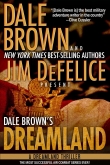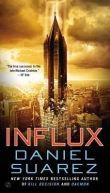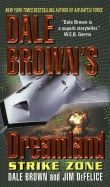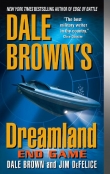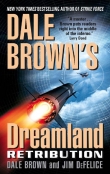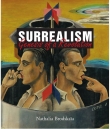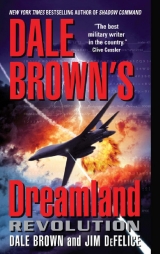
Текст книги "Revolution"
Автор книги: Dale Brown
Жанр:
Боевики
сообщить о нарушении
Текущая страница: 3 (всего у книги 25 страниц)
Samson had seen combat himself in his younger days, and he knew how tenuous courage on the battlefield could be. He also knew that for a soldier to get the Medal of Honor while managing somehow to survive was extremely difficult—luck really, since by definition the sort of selfless act the honor required meant death in nearly every case.
Samson had been on the mission that the President was citing Dog for.
Well, in the theater at least—and even a vague association provided at least a modicum of reflected glory. A commander takes responsibility for all that his people do, good and bad; personal feelings toward Dog aside, the colonel’s success reflected well on his commanding officer, no matter how far removed from the actual event.
But as Samson thought about the implications, his mood quickly sank. For one thing, he wanted Bastian gone from Dreamland, and the medal would make it harder to push him out. It might even be impossible if Bastian decided to fight.
Worse, what if Bastian put his hand up to become wing commander? How could he refuse a Medal of Honor winner?
Bastian wasn’t a full colonel, and wing commanders almost always were. But hell, the guy had held a post a major general now commanded, and had won a Medal of Honor in combat—only a supercilious prig would deny him the post if he truly wanted it.
How did Bastian get the medal, anyway? Samson wondered. Wasn’t the process normally begun with a recommen-
44
DALE BROWN’S DREAMLAND
dation from his commander? In what drunken stupor had he written that recommendation?
Samson’s phone rang. He picked it up, and heard his chief civilian secretary, Chartelle Bedell, tell him in her singsong voice that Admiral Balboa was on the line.
“Samson,” he said, pushing the button to make the connection.
“General. Congratulations are in order,” said Balboa.
“Your command is to receive an armful of medals for the action off India and Pakistan.”
“We heard rumors, Admiral. I was wondering, though.
Usually—”
“The order comes directly from the commander in chief,”
continued Balboa. “And as a matter of fact, he wants to meet with the personnel in question personally. As soon as possible.”
“Sir, I—”
“You have a problem with that, Samson?”
“Of course not, Admiral. We’d be honored to have the President here. The security arrangements—”
“Make them. There’ll be no press. The President happens to be on his way to the coast for some conference or other and wants to personally shake Colonel Bastian’s hand. It’s his idea, Terrill. He loves to press the flesh. You know that. I’m surprised he’s not more concerned about germs.”
“Well yes, sir, of course.”
“You can expect him first thing in the morning. Throw out the red carpet.”
“Tomorrow?” asked Samson, but it was too late—Balboa had already hung up the phone.
Northeastern Romania
2031
THE ATTACK ON THE GAS LINE WAS MADE SEVERAL HOURS
earlier than General Locusta expected, and his first reaction REVOLUTION
45
was genuine surprise and anger. Locusta was in the small house used as his army corps headquarters, having a late tea with some of his officers, when word came. The news was delivered by a Romanian army private who’d driven from the attack site five miles away; the man had sprinted from the parking area and barely caught his breath before delivering the news.
“Where?” demanded Locusta. “Have they been repulsed?”
“They are gone, General,” said the man. “We have had two casualties.”
“Two?”
The private nodded.
“How many guerrillas were killed?”
The man shook his head. While that was probably a good thing—had the men been killed, it was very possible their true identities would have been discovered—Locusta was furious.
The Russian had promised him none of his men would be harmed. The general had practically gift wrapped the pipeline for him, and he responded by killing two of his men.
That was what came from working with the Russians.
“General?” the private prodded him.
“The pipeline is broken?” asked Locusta.
“There was an explosion. Our captain was ordering the line closed as I left.”
“I will inspect it myself.” Locusta turned to one of his captains. “Send a message to the capital immediately. Tell them to shut the entire line down. As a precaution. Add that the situation is under control for the moment and I am on my way personally to inspect the site.”
Dreamland
1034
“COMFORTABLE, ZEN?” ASKED ANNIE, TALKING TO HIM
through the radio in the test helmet.
46
DALE BROWN’S DREAMLAND
“I’m just about to nod off,” he replied.
“I’ll bet. We’re counting down from five. Here we go. Five, four … three … ”
Zen flexed his arms. He was sitting on a high-tech alumi-num step ladder—it looked more elaborate than the models you’d find in a hardware store, but that was essentially what it was. Besides the MESSKIT, he was wearing a harness attached by very thick rubber straps and nylon safety ties to anchors on the “gym” ceiling, walls, and floor. Thick cushion pads covered nearly every surface in the hangarlike room; the only spaces left unprotected were small clear plastic panels for video cameras and various sensors, and the window of the control room, protected by a webbed net that hung across the open space.
Zen took a last look across at the control room—it was at about eye level, ten feet off the ground—and thought to himself that it would be just his luck to be propelled into the netting like a school of mackerel if the experiment went haywire.
“Ladder away,” said Annie, continuing the countdown.
The metal seat that had been supporting him slid back.
Zen didn’t move—his weight was now entirely supported by the safety harnesses, which were quickly checked by the computer monitoring the test.
“Green light on ladder retrieve,” said one of the techies in the control room.
Behind him, the ladder’s “closet” opened and the ladder began folding itself away. But Zen was too focused on the MESSKIT to pay any attention. The device seemed to barely weigh anything.
“We’re ready any time you are, Zen,” said Annie.
“Opening the umbrella,” he said, extending his arms before pushing the button on the control in his left hand.
The wings unfolded with a loud thump, the sort of sound a book makes falling off a desk. Zen was tugged upward gently. He pushed his arms back, spreading his wings—the skeleton and its small bat wings moved easily.
REVOLUTION
47
Zen worked left and right, just getting used to the feel, while Annie and the others in the control room monitored the device. After a few minutes, the tension on the suspension straps holding him off the floor was eased. Zen settled about six inches, then another six; he flapped his arms playfully, not trying to fly, but testing the safety equipment to make sure everything was still in order.
“All right, the safety harnesses are working,” said Annie.
“We’re going to give you some breeze. If you’re ready.”
“Let ’er rip,” Zen said, and leaned forward, anticipating the next set of tests as some of the giant cushions on the wall slid upward to reveal small louvered slots.
“Two knots, then five,” said Annie.
Even at two knots, the effect of the wind on the wings was immediately noticeable. Zen pushed his hands down as the wind hit his face; the microsensors in the MESSKIT’s skeleton transferred his movements to the small motors that controlled the wing’s surface, and suddenly he was pitched downward. The guide ropes and harness kept him from going too far forward, but the shift was still an abrupt enough to catch him by surprise.
“Wow,” he said. “I’m flying.”
“Not yet, Major,” said Annie dryly. “Maybe by the end of the day.”
Dreamland
1345
THE ENGINEERS WHO TRANSFORMED THE B-1B INTO
Dreamland B-1B/L Testbed 2 had left the throttle controls to the left of each pilot’s position, but otherwise there was little similarity between the aircraft’s cockpit and that of its
“stock” brethren. A sleek glass panel replaced the 1970s-era gauges, dials, and switches that had once faced the pilots.
The panel layout was infinitely configurable and could be 48
DALE BROWN’S DREAMLAND
changed by voice command to different presets adapted to a specific mission or pilot. The electronics behind the panel were even more radically different. Dreamland B-1B/L Testbed 2 could simultaneously track 64,237 targets and potential threats anywhere in the world. The number was related to the processing capacity of the chips used in the radar and computers but was still somewhat arbitrary. Ray Rubeo’s answer, when Dog asked him why that number was chosen, had been,
“They had to stop somewhere.”
Gathering the data through the Dreamland communication network—and eventually through standard military systems—the plane’s advanced flight computer could not only keep tabs on any potential enemy in the world, but provide the pilot with a comprehensive plan to evade detection or destroy the enemy before it knew the plane was targeting it.
Or the computer could do it all itself, without human help—or interference. Which was what today’s test was all about.
“Ready any time you are, Colonel,” said the copilot, Marty
“Sleek Top” Siechert. A civilian contractor, a former Marine Corps aviator who’d returned to flying fast jets after working as a mid-level manager at McDonnell Douglas, Siechert’s nickname came from his bald head, which looked like a polished cue ball.
Not that Dog could see it. Both men were dressed in full flight gear, with g suits and brain buckets, even though the cabin was fully pressurized.
“Let’s get this pony into the air,” said Dog, putting his hand on the throttle.
Dreamland B-1B/L Testbed 2—more commonly and affec-tionately known as Boomer—rocked as her engines revved to life. The four General Electric F101-GE-102 engines she was born with had been replaced by new GE models that were about seventy percent more powerful and conserved much more fuel. Unlike the Megafortress, the B-1B was a supersonic aircraft to begin with, and thanks to its uprated engines, had REVOLUTION
49
pushed out over Mach 2.4 in level flight—probably a record for a B-1B, though no one actually kept track. More impressive—at least if you were paying the gas bill– Boomer could fly to New York and back at just over the speed of sound with a full payload without needing to be refueled.
“I have 520 degrees centigrade on engines three and four,”
said Sleek Top.
“Roger that,” replied Dog. The temperature readings were an indication of how well the engines were working. “Five twenty. I have 520 one and two.”
They ran through the rest of the plane’s vitals, making sure the plane was ready to takeoff. With all systems in the green, Dog got a clearance from the tower and moved down the ramp to the runway.
“Burners,” he told Sleek Top as he put the hammer down.
The afterburners flashed to life. The plane took a small step forward, then a second; the third was a massive leap. The speed bar at the right of Dog’s screen vaulted to 100 knots; a half breath later it hit 150.
“We’re go,” said Dog as the airplane passed 160 knots, committing them to takeoff.
The plane’s nose came up. Boomer had used less than 3,000 feet of runway to become airborne.
Like the stock models, the B-1B/L’s takeoff attitude was limited to prevent her long tail from scraping, and the eight-degree angle made for a gentle start to the flight. Gentle but not slow—she left the ground at roughly 175 knots, and within a heartbeat or two was pumping over 300.
Dog checked the wing’s extension, noting that the computer had set them at 25 degrees, the standard angle used for routine climb-outs. Like all B-1s, Boomer’s wings were ad-justable, swinging out to increase lift or maneuverability and tucking back near the body for speed and cruising efficiency.
But unlike the original model, where the pilots pulled long levers to manually set the angle, Boomer’s wings were set automatically by the flight computer even when under manual 50
DALE BROWN’S DREAMLAND
control. The pilot could override using voice commands, but the computer had first crack at the settings.
The wings’ geometry capitalized on improvements made possible by the use of the carbon composite material instead of metal. The goal of these improvements had been to reduce weight and improve performance, but as a side benefit the new wings also made the plane less visible on radar.
They were also, of course, considerably more expensive to manufacture than the originals, a problem the engineers were finding difficult to solve.
It was also a problem that Dog no longer had to worry about or even consider. All he had to do was finish his climb-out to 35,000 feet and get into a nice, easy orbit around Range 14a.
“Way marker,” said his copilot. “We’re looking good, Colonel. Ready for diagnostics.”
“Let ’em rip,” said Dog.
The B-1Bs flown by the Strategic Air Command were crewed by four men: pilot, copilot, and two weapons systems operators. Boomer had places for only the pilot and copilot, with the weapons handled by the copilot, with help from the threat and targeting computer. The arrangement was under review. Experience with the Megafortress had shown that under combat conditions, dedicated weapons handlers could be beneficial. There was plenty of room for them on the flight deck, but the additional cost in terms of money and man-power might not be justifiable.
Indeed, Dog wasn’t entirely sure the presence of the pilot and copilot could be justified. The Unmanned Bomber project, though still far from an operational stage, demonstrated that a potent attack aircraft could be flown effectively anywhere in the world from a bunker back in the States. The next generation of Flighthawks—the robot fighters that worked with the Megafortress as scouts, escorts, and attack craft—would contain equipment allowing them to do just that, though they still needed to be air-launched.
REVOLUTION
51
The next generation of Flighthawks was very much on Dog’s mind as the diagnostics were completed, because the afternoon’s test session was a mock dogfight between a pair of Flighthawks and the B-1. The aim of the test was to put Boomer’s airborne laser through its paces, but of course from the pilots’ point of view, the real goal was to wax the other guy’s fanny.
Dog wondered if the computers thought like that.
“Boomer, this is Flighthawk control. Hawk One and Two are zero-five minutes from the range. What’s your status?”
“Rarin’ for a fight, Starship,” responded Dog. “Are you ready, Lieutenant?”
“Ready to kick your butt,” said Starship.
Dog laughed. Starship—Lieutenant Kirk “Starship”
Andrews—seemed to have broken out of his shell a bit thanks to his temporary assignment with the Navy. In fact, he’d done so well there that the commander he’d been assigned to, Captain Harold “Storm” Gale, had tried to keep him. Considering Storm’s general attitude that Air Force personnel rated lower than crustaceans on the evolutionary scale, his attachment to Starship was high praise.
“I didn’t mean any disrespect, sir,” added Starship hastily.
“No offense taken,” said Dog. “Let’s see how you do, Lieutenant.”
Dog and Sleek Top turned over control to the computer and settled back to watch how Boomer did. The tests began quietly, with the two Flighthawks making a head-on approach at Boomer’s altitude. The B-1’s radar tracked them easily, identified them as threats, presented itself with several options for striking them, then worked out the solution most likely to succeed.
The computer system used to guide the Flighthawks—known as C3—already did this, but the task was considerably more difficult for a laser-armed ship. While in sci fi flicks lasers regularly blasted across vast tracts of space to incin-erate vessels moving just under the speed of light, back on 52
DALE BROWN’S DREAMLAND
earth lasers had not yet developed such abilities—and might not ever. The laser weapon aboard the B-1 fired a focused beam of high-energy light that could burn a hole through most materials known to man, assuming it stayed focused on its target long enough.
And that was the rub. Both Boomer and its airborne targets were moving at high rates of speed, and while there might be some circumstances under which the B-1B/L could count on getting off a sustained blast of ten or more seconds, dogfight conditions meant that blast length would often be measured in microseconds.
For the laser to be a practical air-to-air weapon, its enemy’s specific vulnerabilities had to be targeted and then hit repeatedly. That was where the computer did most of its number crunching. It was able to assess the typical vulnerabilities of its opponent, prepare what was called a “shooting plan” to exploit those vulnerabilities, and then direct the laser fire as both aircraft moved at the speed of sound. And it could change that plan as the battle progressed.
For example, if the B-1 was tangling with a MiG-27, the computer would realize that the motors the MiG used to adjust its wings in flight were extremely heat sensitive. Depending on the orientation of the two planes, the computer would target those motors, crippling his enemy. As the MiG
slowed down to cope with the malfunction, the computer would then fire a series of blasts on the port wing fuel tank, aiming not to punch holes in the wing, but to create a series of hot spots in the tank, which would disrupt the fuel flow, slowing the plane down. For the coup de grace, the computer would ignite the antiair missile on the plane’s right wing spar, in effect having the MiG destroy itself.
This would all happen in a span of seconds. While the human controlling the weapon could approve each individual targeting stage, ideally he would simply tell the computer to take down the bandit, and he could then worry about something else.
REVOLUTION
53
A MiG-27, though relatively fast, was an easy target, since it was big, conventionally flown, and most important of all, well-known. The Flighthawks, by contrast, were much more difficult opponents. Not only had they been designed to mini-mize some of the traditional vulnerabilities, but their lack of a pilot removed one of the laser weapon’s neatest tricks—blasting the cockpit with heat and making the enemy pilot extremely uncomfortable.
“We’re ready,” declared Sleek Top as they finished the first battery of tests. “Clear computer to engage in encounter.”
“You feeling lucky yet?” Dog asked Starship.
“Don’t need luck, Colonel.”
“Let’s do it.”
The Flighthawks swung east, preparing to make their attack. The Flighthawks—officially, U/MF-2/c, which stood for “unmanned fighter 2, block c”—were about the size of a Honda Civic and were equipped with cannons. They were slower than the B-1B/L but more maneuverable.
On the first test, everyone followed a prepared script. The two Flighthawks passed a quarter mile to the east. The computer picked them up without trouble, adjusted Boomer’s speed to get longer shots on their engines, and then recorded a simulated hit.
“Two birds down,” reported the copilot.
“Hear that, Starship?” said Dog. “You’re walking home.”
“I always walk home, Colonel. Ready for test two?”
“Have at it.”
The Flighthawks banked behind Boomer and began to close, aiming to shoot their cannons at the fat radar dome at the plane’s tail. This was a more realistic attack scenario, and was further complicated by Starship’s handling of the planes—he kept them jinking and jiving as they approached, making it difficult for Boomer to lock its laser. The fact that there were two targets made things even more complicated, as the computer had trouble deciding which of the two aircraft provided a better target and kept reordering its plan of attack.
54
DALE BROWN’S DREAMLAND
“I’m tempted to do an override,” said Sleek Top, who could have solved the computer’s problem by designating one of the planes as primary target.
“Let’s see how it does.”
The words were barely out of Dog’s mouth when the laser fired, recording a simulated hit on Hawk One. It took nearly thirty seconds, but it recorded a fatal strike on Hawk Two as well.
Then the fun began.
“On to test three, Colonel,” said Starship.
“Anytime you’re ready, son.”
The Flighthawks dove toward the earth. Test three was entirely free-form—Starship could do anything he wanted, short of actually hitting Boomer, of course.
“Tracking,” reported Sleek Top.
Dog could see the two aircraft in the radar display; they were about a mile off his wing. They changed course and headed toward Glass Mountain, at the very edge of the test range.
“Why’s he running away?” Sleek Top asked.
“He’s not. He’s going to get lost in the ground clutter. He wants us to follow, hoping we’ll be impatient.”
“Are we going to?”
Had Dog been flying the plane, he would have: It was more macho to beat the other guy in the battle he chose. But the B-1’s computer made the right decision, at least by the playbook it had been taught—don’t get suckered into the battlefield the other guy wants you to fight. It maintained its position.
“He’s off the scope.”
“Mmmmm,” said Dog.
Boomer increased the distance between itself and its ad-versary. Starship would be able to track his position and would soon realize that he wasn’t biting.
What would he do then?
“Here we come,” said Sleek Top. He read out the course and REVOLUTION
55
heading of the first contact, Hawk One, which was streaking toward them from the west.
“So where’s the other?” asked Dog.
“Still in the bushes somewhere.”
The computer abruptly threw the plane on its left wing, plunging toward the earth—just as the second Flighthawk appeared on his screen to the east, almost directly below him.
“How the hell did he do that?”
Dog resisted the temptation to grab the stick as the big airplane pulled to its left. Too late, Boomer’s computer realized it had been suckered– Hawk One, flying directly behind Hawk Two so its radar profile couldn’t been seen, had snuck onto the laser ship’s tail.
“Bang, bang, you’re dead,” said Starship as the computer recorded a fatal blast from the Flighthawk.
“Damn,” said Sleek Top.
Actually, the computer had done very well. Only Starship’s skill—and the young man’s battle-tested cleverness—had defeated it.
“What do you say, best two out of three?” said Sleek Top.
“I have a better idea,” said Starship. “Go to manual controls.”
That was a gauntlet Dog couldn’t resist—though he checked to make sure they still had plenty of time on the range.
“You’re on,” said the colonel, circling around as the Flighthawks disappeared again.
“I’d like to see him try that again.”
“He won’t,” said Dog.
Actually, Starship tried something similar. Having learned that he could fool most radars by flying the Flighthawks extremely close together, he lined Hawk One and Two back up and then came at Boomer from above. Dog, thinking Starship was trying to sneak one of the UM/Fs in at him off the deck—another favorite trick to avoid radar—realized what was going on a fraction of a second too late. As Hawk Two 56
DALE BROWN’S DREAMLAND
came onto his tail, he pushed his nose down, outaccelerating it before Starship could fire.
Then he banked hard, flattened the plane out, and turned the tables on the Flighthawk as it started to recover.
“Fire,” he told Sleek Top calmly.
“Can’t get a lock—he’s jinking and jiving too much.”
“Stay on him,” said Dog. His own hard g maneuvers were part of the problem, as his free-form flight path made it hard for the laser to get a bead on its enemy. Dog put his nose straight down, trying to turn into Hawk Two and give Sleek Top a better shot. But before he could get his nose where he wanted it, the other Flighthawk started its own attack run, and Dog found himself between both of them. He pushed hard left, felt the aircraft starting to invert—then got an idea and pushed her hard in the other direction. Boomer wob-bled slightly, fierce vortexes of wind buffeting her wings, but it held together and followed his commands. Dog jammed his hand on the throttle, accelerating and turning his belly toward Hawk One.
“Locked!” said Sleek Top.
“Fire!” answered Dog. “Don’t wait for me.”
The computer gurgled something in his ear—a warning saying that flight parameters were being exceeded. Dog ignored the warning, rolling Boomer’s wings perpendicular to the earth. For two or three seconds his belly was exposed to Hawk Two.
Two or three seconds was all the computer needed.
“Splash Hawk Two, ” shouted Sleek Top, his normally placid voice alive with the excitement of the contest.
“Where’s Hawk One?”
“Still tracking. Our left. Parallel.”
The laser had not been able to stay with Starship’s evasive maneuvers, and now Dog found himself in trouble. The B-1 had used up much of its flight energy, and to prevent itself from becoming merely a falling brick, had to spread its wings. That was a dead giveaway to Starship that his adver-
REVOLUTION
57
sary was weak, and the fighter jock did what all fighter jocks are bred from birth to do—he went for the jugular. He pulled Hawk One onto Dog’s tail, aiming the cannon in his nose at the big tail filling his gun screen. Dog ducked and rolled, trying to trade altitude for enough speed to get away.
While he managed to keep Hawk One from getting a clean shot, he couldn’t set one up for himself either. The Flighthawk kept closing, angling to stay above the laser’s angle of fire. Finally, there was only one way to extricate himself: Dog reached for the throttle and lit his afterburners, outaccelerating the smaller craft.
Or running away, depending on your point of view.
“I’d say that’s a draw,” said Starship over the radio.
“Draw my foot,” answered Sleek Top. “We got one of yours.”
“I kept you from accomplishing your mission,” said Starship smugly.
“Our mission was to shoot you down.”
Dog laughed. He was going to miss these guys when he left Dreamland.
Northwestern Moldova,
near the Romanian border
2345
STONER PUT HIS HEAD DOWN AND HELD HIS BREATH AS THE
truck passed a few yards away. There was a hole in its muffler, and the engine coughed every fifth or sixth revolution, chuttering and sending smoke out from the side. The noise drowned out the sound from the second truck, and was so loud Stoner wasn’t sure there were any others behind them.
He waited a few seconds, then raised his head cautiously.
There were no other vehicles.
“Smugglers,” said Deniz, the Romanian army corporal.
“What are they taking across?”
58
DALE BROWN’S DREAMLAND
“This way, nothing. They can come back from our country with anything. Food. Medicine.” He paused and smiled.
“Women.”
Stoner couldn’t tell whether that was meant to be a joke.
“How do they pass the checkpoints?”
“Twenty euros. I tell you, we could have driven.”
Stoner got up from behind the stone wall. Deniz whistled to Kyiv, the other Romanian soldier, who came out from behind the tree where he’d been hiding. The three men resumed their walk along the dirt road. It had taken nearly three hours for them to cover five kilometers, largely because Stoner was being overly cautious, stopping even when he heard aircraft passing overhead. Being late, he knew, was not as big a problem as not arriving at all.
The long trek had given him more time to judge his guides. As soldiers, they were more competent than he’d thought at first, good at spotting possible ambush points and wary enough to plot escape routes before moving through fields they weren’t already thoroughly familiar with. He trusted them, to a point, but knew that if they were captured by guerrillas, it wouldn’t take much for them to give him away.
Deniz said something to Kyiv and the two men laughed.
Stoner frowned, figuring it was probably some sort of joke at his expense.
“We are almost there. We stay on the road unless we hear something,” said Deniz, gesturing. “Two hundred meters.”
Stoner grunted, thinking, watching. He had a pair of night vision goggles in his pack, but there was more than enough light from the moon to see along the road and well into the nearby fields. The steeple of a church stood up on the right, marking a hamlet. Two houses sat near a bend in the road ahead. Otherwise, the way was clear.
Even though there were no lights shining in the windows or smoke coming from the chimneys, Stoner had Kyiv lead them into a field opposite the two houses so they could pass REVOLUTION
59
without taking any risks. The field connected with another; a narrow farm lane ran north along the end of this second field, separated from a neighboring farm by a thick row of trees.
Stoner put his night vision glasses on as he walked, growing warier as the shadows in the distance multiplied. But nothing was stirring.
The detours cost them another fifteen minutes. Finally, he saw the ramshackle barn where he was supposed to meet his contact. It stood above the field on the opposite side of the road, its foundation built into the crest of the hill.
He scanned the building carefully, then shook his head.
“So?” asked Deniz.
“I don’t see anyone.”
“No?”
Stoner turned his view to the nearby field. It too was empty.
The Romanians watched him silently. They weren’t joking any more, nor whispering. For most of the night they’d left their rifles slung lazily over their shoulders. Now they held the guns with both hands, ready.
Stoner began moving to his right, keeping the barn in sight. The dirt and dead grass had heaved up with the evening frost, and it crunched as he walked. After he’d gone about thirty yards, he stopped and once again carefully examined the barn and nearby fields.
No one.
Slowly, he made his way up the hill, the two Romanian soldiers trailing behind him. About five yards from the barn, Stoner saw a shadow on the ground in front of it. He froze, steadied his gun.
“Champagne,” he said loudly.
The shadow moved, revealing itself as a man with a rifle.
“Champagne,” repeated Stoner. He curled his finger against the AK’s trigger, slowly starting to apply pressure.
“Parlez-vous français?” said the shadow. Do you speak French?
60
DALE BROWN’S DREAMLAND
That wasn’t the agreed upon phrase, and the accent was so un-French that Stoner had trouble understanding it.
“Champagne,” he said again.
“Vin blanc,” answered the shadow. White wine.

